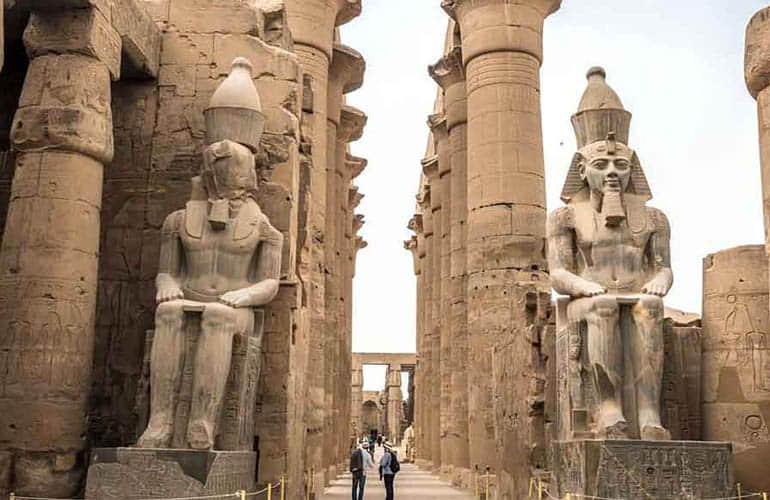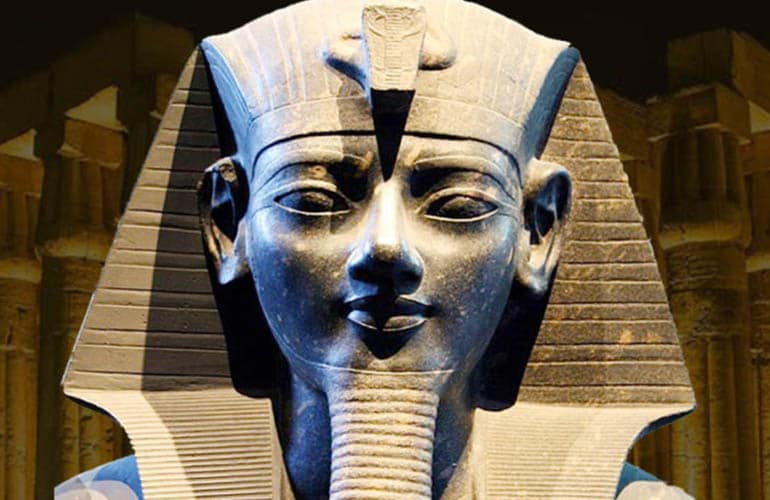Luxor Temple, Egypt
Luxor Temple: Luxor is now a small town of 60,000 inhabitants, located on the right bank of the Nile, on the site of ancient Thebes. The name of Luxor derives from the Arabic word el-Uqsor, plural of el-Qasr which means camp or fortification, referring to two military camps that were established here in Roman times.
The constructions that the Egyptians dedicated to their gods give us an idea of the importance that these had in their lives. The temple of Luxor is an outstanding example, which was successively occupied by several pharaohs. The result: a superb monument that reflects the worship of the Egyptians for their divinities, but also the power and magnificence of the ancient empire.
The courtyard is composed of 74 columns in which you can see the pharaoh with different deities. In the center, a sanctuary consists of three chapels, dedicated to Amun, Mut, and Junsu, decorated by Ramses II. They served as storage for the sacred boats.

Builders of Luxor Temple
Two great builders as Amenhotep III and Ramses II were the main responsible for the construction of the temple dedicated to Amun: during the rule of Amenhotep III was built the interior, and the outer enclosure was built under the mandate of Ramses II. But they were not the only ones who left their mark on the great temple Tutankhamun, Horemheb and even Alexander the Great himself mobilized their workers in pursuit of immortalization.

The temple of Luxor, the sanctuary of the ka par excellence, is 260 meters long It is linked to the temple of Karnak by a long avenue decorated with sphinxes once with the head of a ram, replaced by sphinxes with human heads
Description of Luxor temple in Egypt
At the entrance to the temple stands the monumental pylon built by Ramses II, which has a front of 65 meters long. In it is sculpted bas-reliefs that tell the military campaign of Ramses II against the Hittites and is engraved the famous Poem of Pentaur, which celebrates the warrior exploits of the pharaoh.
In front of the pylon, there were formerly two obelisks of Ramses II that rose to the sky to dissipate the harmful forces and attract the celestial powers to the temple, of which today only remains the left one, 25 meters high, because the other was transported to France in 1833 in the center of the Place de la Concorde.
Surrounding the entrance, two statues, made of red granite 15.50 meters high on a 1-meter pedestal, represent the Pharaoh sitting on his throne, Once this triumphal entrance is crossed, one arrives at the great Court of Rameses II decorated with a double row of columns with papyriform capitals, with statues of Osiris in the intercolumns. The court also raises the small temple of Thutmose III composed of 3 chapels dedicated to the triad of Amun, Mut, and Khonsu.
An imposing colonnade of 25 meters introduces us then in the court of Amenophis III, surrounded on three sides by a double row of papyriform columns. The exterior of the temple also has interesting aspects, with its walls provided with numerous side chapels whose walls are adorned with scenes of religious ceremonies and, here too, with scenes of the battle against the Syriac-Haitite coalition.
The temple of Luxor originally comprised a large colonnade with fourteen papyriform columns 19 meters high (its circumference measured almost 10 meters), bounded on the east and west by a wall decorated with reliefs inspired by moments of the Opet festival. Through the colonnade, which was completed and decorated in the time of Tutankhamun (1334-1325 B.C.), one entered the magnificent courtyard closed by a double row of columns, delimited to the south by the hypostyle hall. From there, one went to the inner part of the temple, which comprises a series of four antechambers, some accessory rooms and the sanctuary of the sacred boat, which corresponds to the innermost room, whose pavilion was reconstructed by Alexander the Great.
Temple of Luxor at night
The temple follows quite faithfully the model of the classical constructions: it consists of a large central courtyard, a hypostyle room, a vestibule, and a sanctuary. The entrance to the temple was decorated with a poem by Pentaur, alluding to the value of the pharaoh in battle. Two obelisks were erected at the front: one of them, 25 meters high, remains there, while the other was moved to Place de la Concorde in Paris in 1836 as a gift from Mohamed Ali. The entrance is also where the seated statues of Ramses II are located, of unimaginable size, decorated with images of prisoners representing the nine peoples conquered by Egypt. They are made of gray granite and measure more than 15 meters and a half high.
[ Enjoy the best Luxor Day Tours ]

The temple of Luxor had a complex function
Every year, in its most secret rooms, during the feast of Opet, the divine rebirth of the pharaoh, son of Amon, was celebrated to reaffirm his power. In the half-light of the “divine birth room”, Amon, who for the occasion assumed the appearance of the pharaoh, went to meet the queen to whom Tot, the god with the head of an ibis, predicted her future destiny as a mother. Amon then ordered Knum, “the divine potter”, to model on the wheel the child in gestation and its ka, its “double”, which would represent its divine and immortal essence. The queen, with the help of Hathor, Isis and Nephthys gave birth to her divine son, son of the king of the gods, thus recognized by father Amon. And he presented incense offerings and fresh flowers to Amon and received in return the divine nature, youth, and promises of long life; then he was crowned as the rightful ruler of the Two Lands. The Pharaoh thus regenerated and reconfirmed in his royal role could secure prosperity for his people for another year.
Facts you should know about the temple of Luxor:
Who was the pharaoh of the Exodus?
One of the curiosities of this temple the son of Ramses II who are going to inaugurate the temple. It is believed that this pharaoh Ramses II, who is believed to have died at the age of 94, had more than 100 sons and daughters, with his four royal wives plus the secondary wives and concubines. In this engraving of princes, the number 13 is the future Pharaoh Merneptah, the successor to Ramses II, who is believed to have been the pharaoh of the exodus of the Jews led by Moses.
The Mosque of Abu’l Haggag at Luxor Temple
The Temple of Luxor was completely buried for many centuries. This has meant that shortly after entering the interior of the temple, one finds a mosque on top of one of the walls. This mosque is not a recent construction but has a thousand years of history, so it has been decided to keep it because it is also the symbol of how in this temple is combined the passage of three different religions, two monotheistic and one polytheistic.
The history and the different artistic monuments that are in this temple, show us how in this same place different religions were practiced in different times because besides the gods of the Old Egypt, the Muslims also prayed in the mosque and the Christians in a chapel at the end of the temple.
Christian Church in Luxor temple
One of the areas that will undoubtedly draw your attention are the Corinthian capitals at the end of the temple. If we go into the place, you will see that you are going to find some poorly preserved frescoes, because this is where the Christian church was built.
Alexander The Great in Luxor temple
In this temple, you can also see many scenes of offerings and the engravings representing the departure of the boat. Alexander the Great had this room fitted out and, due to the respect and care he showed towards ancient Egypt, it was represented in the reliefs of the temple, where you can see how he was made the son of a god, immortalizing him before the god Amon.






